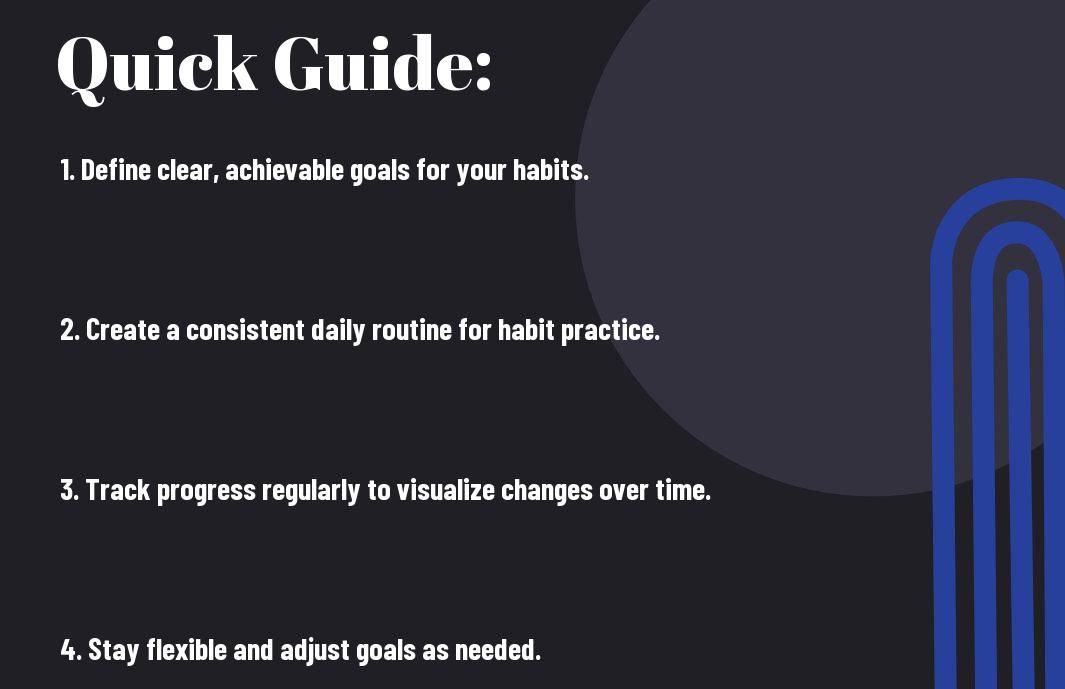Guide your journey toward lifelong success and well-being with our Long-term Habit Maintenance Guide. In this post, you will learn effective strategies to sustain your positive habits over time, ensuring they become an integral part of your daily life. Discover how to navigate challenges, stay motivated, and track your progress, so you can enjoy the benefits of your efforts for years to come. Your commitment to maintaining these habits will shape your future, and with the right tools, you can make lasting changes that align with your goals.
Key Takeaways:
- Consistency is crucial for maintaining habits over time.
- Set realistic goals to ensure continuous motivation and progress.
- Utilize a tracking system to monitor your habits and identify patterns.
- Establish support systems, such as friends or communities, to share experiences and encouragement.
- Mindfulness practices can help in staying aware of your habits and making adjustments as needed.
- Celebrate small victories to reinforce positive behavior and maintain enthusiasm.
- Be patient with yourself; setbacks are normal and can be opportunities for growth.
Understanding Types of Habits
A habit can be categorized into different types, each playing a distinct role in shaping your daily life. Understanding these types allows you to focus on what you want to cultivate or change.
| Type of Habit | Description |
|---|---|
| Healthy Habits | Positive actions that boost your physical or mental well-being. |
| Productive Habits | Behaviors that enhance your efficiency and goal attainment. |
| Negative Habits | Actions that can potentially harm your well-being or productivity. |
| Social Habits | Interactions that shape your relationships and social skills. |
| Self-Care Habits | Practices that prioritize your mental and physical health. |
An effective set of healthy habits can drastically improve your lifestyle. This might include regular exercise, a balanced diet, or mindfulness practices, all aimed at enhancing your overall wellness. By incorporating these habits into your daily routine, you can create a healthier, more vibrant life.
Productive Habits
Now, focusing on productive habits can significantly enhance your efficiency and effectiveness in achieving your goals. These habits include prioritizing tasks, setting specific work times, and minimizing distractions.
Habits that foster productivity involve both planning and execution. You can create to-do lists, establish a designated workspace, or employ techniques such as the Pomodoro Technique to stay focused. By intentionally creating an environment conducive to productivity and regularly evaluating your progress, you will find yourself achieving more with less stress.

Tips for Effective Habit Formation
If you want to successfully form lasting habits, consider the following tips:
- Identify your triggers
- Set clear goals
- Track your progress
- Reward yourself for milestones
Perceiving these steps as part of your routine can greatly enhance your habit-building journey.
Start Small
Habit formation begins with manageable actions. By starting small, you can build confidence and gradually increase the complexity of your new habits. For example, if you aim to exercise regularly, begin with just five minutes a day. Small successes will cultivate a positive mindset, making it easier to build upon your initial efforts.
Be Consistent
Some of the most effective habits are built through consistency. By committing to practice your new habit at the same time each day or week, you create a reliable structure that makes it easier to maintain. This could mean setting a specific time for your exercise routine or dedicating a few moments each evening to read.
Another effective strategy is to align your new habits with your existing routines. This can enhance the consistency you seek, making it feel less like a chore and more like part of your lifestyle. For instance, if you want to meditate regularly, you might pair it with your morning coffee. This connection can create a seamless transition, increasing the likelihood of sustained engagement with your new habit.

Step-by-Step Guide to Habit Maintenance
Many individuals struggle with maintaining habits over time. To ensure long-term success, it’s important to follow a structured approach. This step-by-step guide will help you navigate the process effectively. For a deeper probe effective strategies, check out How to Build Habits and Make Long-Term Behavior Change.
Steps to Habit Maintenance
| 1. Set Clear Goals | Define specific, measurable, achievable targets. |
| 2. Create a Plan | Outline the actions necessary to reach your goals. |
| 3. Track Progress | Regularly monitor your advancements and setbacks. |
| 4. Adjust as Necessary | Be open to revising your plan if needed. |
| 5. Stay Accountable | Share your goals with others for added support. |
Setting Clear Goals
One of the first steps in maintaining a habit is to set clear goals. These should be specific and realistic to help keep you motivated. Clearly defined targets will provide a sense of direction and allow you to measure your progress effectively.
Tracking Progress
Goals should always be accompanied by a system for tracking your progress. Regularly recording your activities not only helps you stay accountable but also enables you to see how far you’ve come. This awareness can be a powerful motivator to continue your progress.
StepbyStep tracking can be achieved through various methods like journaling or using mobile apps designed for habit tracking. Make it a daily or weekly practice to review your progress, noting successes and areas for improvement. By doing so, you foster a mindset focused on growth and resilience, critical components for sustaining your habits long-term.

Key Factors Influencing Habit Success
After establishing a routine, several key factors can influence your habit’s success. Understanding these elements is vital for long-term maintenance:
- Environment
- Mindset
- Community Support
- Consistency
- Accountability
Recognizing how these factors interact will empower you to effectively sustain new habits. For more insight, check out How to Build New Habits: This is Your Strategy Guide.
Environment
One of the most overlooked elements in habit formation is your environment. It significantly shapes your ability to maintain habits. By creating a physical space that encourages your desired behavior, you can reduce friction and make it easier to stick to your routine.
Mindset
You must foster a positive mindset to keep your habits on track. Adopting a growth-oriented perspective allows you to view challenges as opportunities rather than obstacles. This shift can motivate you to stick with your habits, even in the face of setbacks.
Influencing your mindset is about cultivating resilience and adaptability. By focusing on progress instead of perfection, you allow yourself the flexibility to grow and learn from your experiences. Embracing this outlook can greatly enhance your commitment to long-term habit maintenance.

Pros and Cons of Long-term Habit Maintenance
For anyone considering long-term habit maintenance, it’s vital to weigh its strengths and weaknesses. Understanding both sides will help you navigate the complexities of developing sustainable behaviors. Below is a breakdown of the pros and cons:
| Pros | Cons |
|---|---|
| Improves overall well-being | Can be time-consuming |
| Increases self-discipline | May lead to burnout |
| Boosts confidence | Requires sustained effort |
| Enhances productivity | Potential for monotony |
| Creates a sense of accomplishment | Can be hard to track progress |
Benefits of Consistent Habits
Clearly, establishing consistent habits provides numerous rewards. You enhance your efficiency and productivity, leading to a greater sense of achievement in your personal and professional life. Over time, these small, daily actions compound, resulting in significant improvements in your health, mental clarity, and overall happiness. As you practice these habits, you also cultivate resilience and adaptiveness, traits that are vital for long-term success.
Challenges and Drawbacks
You will encounter various challenges when maintaining long-term habits. Initially, the process might be quite taxing as you adjust to your new routine. It’s vital to recognize that persistence can wane and motivation may falter over time.
Consistent challenges arise from life’s unpredictability, which can disrupt even the best-laid plans. You might find that unforeseen circumstances, like work pressures or personal commitments, hinder your habit maintenance efforts. Additionally, the lack of immediate results can lead to frustration, making it tempting to abandon your objectives. It’s vital to develop strategies to cope with setbacks and maintain your momentum, refocusing your motivation to stay on track despite any hurdles that may arise.
Tools and Resources for Habit Tracking
Once again, effective habit tracking can significantly enhance your journey towards lasting change. By utilizing various tools and resources, you can monitor your progress, identify patterns, and stay motivated. From digital apps to physical planners, exploring these options will help you find what fits your lifestyle best and keeps you engaged in your habit maintenance.
Apps and Technology
Technology has revolutionized the way you can track your habits. With thousands of apps available, you can choose from simple checklists to comprehensive systems that analyze your data. These tools not only remind you to complete your tasks but also provide insights into your progress, making it easier to stay accountable and motivated.
Community Support
Now, seeking community support can be a powerful tool in your habit maintenance toolkit. Connecting with others who share similar goals creates a sense of accountability and motivation that enhances your commitment to your habits.
It’s beneficial to engage with like-minded individuals, whether through online forums, social media groups, or local meetups. Sharing your struggles and successes with others fosters a supportive environment where you can exchange tips and inspire one another. Being part of a community not only reinforces your commitment but also allows you to celebrate achievements and navigate challenges together, making the process of habit formation more enjoyable.
Conclusion
From above, you can see that long-term habit maintenance requires consistent effort, strategic planning, and a supportive environment. By employing techniques such as setting clear goals, tracking your progress, and celebrating small victories, you can effectively sustain your new habits over time. Engage with your motivations regularly and adjust your strategies as needed to ensure they align with your lifestyle. With dedication and mindfulness, you can create lasting changes that positively impact your life.
Long-term Habit Maintenance Guide FAQ
Q: What are the key components of successful habit formation?
A: Successful habit formation involves several key components including consistency, understanding triggers, setting clear goals, and creating a supportive environment. Establishing a routine helps in reinforcing the habit, while identifying triggers can help you manage and adapt your behavior. Clear, achievable goals provide direction, and a supportive environment can reduce obstacles and encourage persistence.
Q: How can I stay motivated to maintain my habits over time?
A: Staying motivated can be achieved through various strategies such as tracking your progress, celebrating small milestones, and reminding yourself of the benefits of the habit. Engaging in a community with similar goals and finding an accountability partner can also help maintain motivation. Lastly, periodically reviewing and adjusting your goals can reignite your interest and commitment.
Q: What should I do if I feel like I’ve fallen off track with my habit?
A: If you feel that you have deviated from your habit, start by assessing what led to the setback. Reflect on any changes in your routine, environment, or mindset that may have affected your commitment. Then, take small, gradual steps to ease back into the habit. Reinforcement through positive self-talk and focusing on the reasons you wanted to establish the habit in the first place can help regain your momentum.
Q: How can I effectively integrate new habits into my daily routine?
A: To integrate new habits effectively, start with small, manageable changes rather than overwhelming yourself with several new habits at once. Pair the new habit with an established one (known as ‘habit stacking’), set specific times for your new habit, and keep reminders visible. Additionally, find ways to make the new habit enjoyable to foster a positive association.
Q: What role does flexibility play in habit maintenance?
A: Flexibility is important in habit maintenance as it allows you to adapt your approach to changing circumstances and needs. Being too rigid may lead to frustration if things don’t go as planned. Embracing flexibility helps you modify your strategies and maintain your commitment without feeling defeated, particularly when life events or challenges arise.
Q: How can I track my habits effectively?
A: Tracking your habits can be achieved through various methods including using habit tracking apps, journals, or simple checklists. Select a method that suits your style and keeps it engaging. Make it a point to record your progress consistently and visualize your achievements, as this may reinforce your determination to maintain the habit over time.
Q: What are some common pitfalls to avoid when trying to maintain habits long-term?
A: Common pitfalls to avoid include setting unrealistic expectations, neglecting to review and adjust goals, and failing to account for life changes or stressors. It’s also wise to avoid all-or-nothing thinking, as perfect compliance is often unattainable. Learning to be compassionate towards yourself during setbacks, and being open to adjusting your methods, can significantly enhance your long-term success in habit maintenance.

